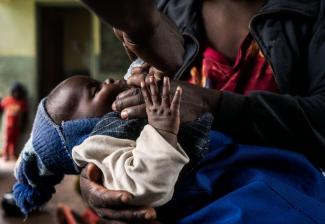OVERVIEW
Over the past decade, investments in the public health system have helped Malawians to live longer, healthier lives. Since 2010, average life expectancy has increased by ten years as a result of increased maternal and child survival, and improvements to prevention, care, and treatment for infectious diseases such as malaria, tuberculosis, and HIV/AIDS. These gains mask important realities and structural dynamics in Malawi’s health system that threaten to undermine progress. Malawi faces an acute shortage of health care workers, and one in three Malawian children remain chronically malnourished.
APPROACH
As Malawi’s largest bilateral partner in the health sector, the U.S. Agency for International Development (USAID) works with the Government of Malawi (GOM) to bolster resilient health systems and support access to high-quality primary health care services, particularly in hard-to-reach areas. USAID invests approximately $150 million a year to advance Malawi’s 2063 vision of a healthy population by helping improve maternal and child survival, control HIV/AIDS, and combat infectious diseases.
KEY RESULTS
- HIV/AIDS: Through the President’s Emergency Plan for AIDS Relief (PEPFAR), USAID supports large-scale HIV care, treatment, and prevention services and gender-based violence prevention. The percentage of Malawians with HIV who are on treatment rose from 5 percent in 2004 to 98 percent in 2021. USAID’s support contributed to Malawi achieving epidemic control.
- PRESIDENT’S MALARIA INITIATIVE (PMI): The U.S. government, through PMI, supports the National Malaria Control Program to provide malaria prevention, diagnosis, and treatment services. With USAID support, Malawi has achieved a 31 percent reduction in malaria burden over the past ten years, and reduced deaths from malaria by 85 percent since 2010.
- FAMILY PLANNING AND REPRODUCTIVE HEALTH: USAID works with the GOM to improve access to high-quality Family Planning services and accelerate reductions in maternal, neonatal and child morbidity and mortality. With USAID support, the total fertility rate has steadily declined from 6.7 births in 1992 to 4.2 in 2020.
- MATERNAL NEONATAL AND CHILD HEALTH: USAID works with the GOM to improve access to high-quality maternal and neonatal health services and address the common causes of preventable maternal and neonatal deaths. With USAID support, Malawi has rapidly reduced maternal mortality and is on-track to achieve the 2030 sustainable development goal of 25 deaths per 1,000 live births for under-five mortality.
- NUTRITION: USAID supports community empowerment and integrated health services to bolster nutrition for children and women, with a focus on the first 1,000 days of life. With USAID support, stunting in under-five children has declined from 47 percent (2010) to 35.5 percent (2022) and vitamin A deficiency in under-five children fell from 59 percent (2001) to less than 5 percent (2016).
- TUBERCULOSIS (TB): In addition to reducing TB incidence through increased use of HIV treatment, USAID is expanding access to high-quality, patient-centered TB diagnosis, cure, and prevention services and the development, adoption and scale-up of novel diagnostic tools and approaches. With USAID support, Malawi has increased the success rates for treatment of drug sensitive and drug resistant forms of TB to 90 percent and 76 percent respectively.
- GLOBAL HEALTH SECURITY AND COVID-19: Building upon its COVID-19 work, USAID is helping to build the GOM’s capacity to prevent, detect, and respond to emerging infectious diseases and public health emergencies. USAID helped to mitigate the impact of COVID-19 by providing personal protective equipment, expanding access to medical oxygen, and accelerating the uptake of the COVID-19 vaccines.
- HEALTH SYSTEMS STRENGTHENING: USAID invests in supply chain management, human resources for health, digital health, and health financing to facilitate a stronger, more resilient health system. USAID also strengthens the health workforce by training, deploying, and retaining health care workers. Through direct government-to-government funding with improved management and supervision, USAID recruited and deployed 387 health care workers in Mangochi and Zomba districts.

Photo by Fredrik Lerneryd, Jhpiego
